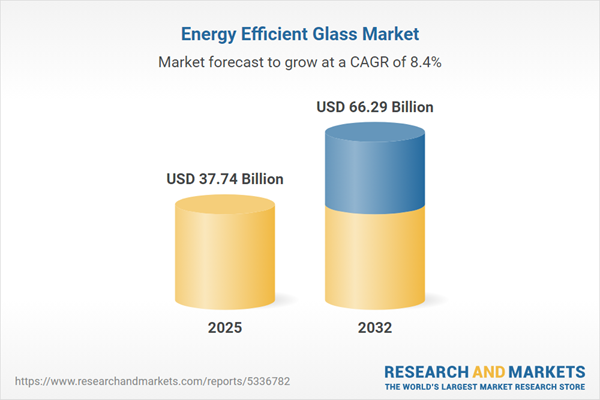Speak directly to the analyst to clarify any post sales queries you may have.
Energy efficient glass is reshaping the trajectory of sustainable construction and transportation sectors worldwide, serving as a critical component for organizations seeking to improve energy performance, occupant well-being, and compliance with evolving standards. As awareness of environmental impact grows across industries, solutions that optimize both thermal and acoustic properties have entered mainstream project specifications, driving market momentum.
Market Snapshot: Energy Efficient Glass Market Growth and Drivers
The energy efficient glass market grew from USD 34.82 billion in 2024 to USD 37.74 billion in 2025 and is forecast to achieve USD 66.29 billion by 2032, reflecting a robust CAGR of 8.38%. Escalating demands for reduced energy costs, compliance with increasingly stringent building codes, and pressure to lower carbon footprints are fueling investments in innovative glass technologies across residential, commercial, industrial, and automotive applications. Market participants are responding by expanding product portfolios and optimizing supply chains to address both new-build and retrofit projects globally.
Scope & Segmentation
- Product Type: Featuring insulated glass (air-filled and gas-filled), laminated glass, low emissivity glass (hard coat and soft coat), smart glass, and tinted glass variants targeted at a range of performance and aesthetic needs.
- Technology: Incorporating double glazing, dynamic coating, multi-layer insulation, triple glazing, and vacuum insulated glass options that deliver varying thermal and light transmission characteristics.
- End User: Covering automotive manufacturers, commercial developers (new construction and retrofits), industrial facility operators, and residential sectors seeking energy efficiency and comfort upgrades.
- Application: Targeting curtain walls, doors, facades, skylights, and window solutions for diverse building envelopes and vehicle cabins.
- Distribution Channel: Direct sales, distributors, online retail, and physical retailers, enabling project customization and broad market access.
- Regional Segmentation: Analyzing Americas (including North and Latin America), Europe, Middle East & Africa, and Asia-Pacific, with sub-regional focus on key economies and growth opportunities.
- Company Coverage: Assessment includes AGC Inc., Saint-Gobain S.A., Guardian Industries Holdings, Nippon Sheet Glass Co., Ltd., Asahi India Glass Limited, SCHOTT AG, AGC Glass Europe SA, Vitro, S.A.B. de C.V., Cardinal Glass Industries, LLC, and Central Glass Co., Ltd.
Key Takeaways for Senior Decision-Makers
- Energy efficient glass adoption is accelerating as organizations align with net zero frameworks and respond to global, region-specific policy requirements.
- Technological advances—such as dynamic coatings, vacuum insulation, and integration with digital building management—are setting new benchmarks for performance, efficiency, and adaptability.
- Collaboration among manufacturers, material scientists, and supply chain partners is strengthening resilience and driving product customization to local standards and climates.
- Winning strategies combine vertical integration, after-sales services, and digital tools to enhance project delivery and long-term customer value.
- Servitized retrofit models and financing aligned to energy certifications are unlocking capital for both new construction and upgrades, fostering deeper market penetration.
Tariff Impact: Navigating Recent U.S. Trade Adjustments
The 2025 revision of U.S. tariffs on coated flat glass and certain substrates has led to higher input costs and supply chain complexity, affecting margins and project schedules for manufacturers relying on international sourcing. In response, industry players are increasingly adopting nearshoring, backward integration, and collaborative ventures with domestic partners to limit exposure and secure material continuity, supporting ongoing sustainability and compliance priorities.
Methodology & Data Sources
This analysis is based on primary research—including interviews with executives, site visits, and laboratory observations—complemented by extensive secondary data from technical publications, regulatory documents, patent databases, and trade association reports. Findings are triangulated across data sources to ensure accuracy, and segmentation frameworks are applied to regional, technological, and end-use analyses.
Why This Report Matters
- Enables senior leaders to navigate complex regulatory, supply chain, and technological landscapes in the energy efficient glass sector.
- Delivers actionable insights on market drivers, product innovation, and region-specific opportunities for robust strategy planning and investment decisions.
- Equips organizations with frameworks to optimize procurement, align sustainability initiatives, and accelerate time-to-market for advanced glazing solutions.
Conclusion
Strategic adoption of energy efficient glass is essential for organizations targeting energy, cost, and sustainability objectives. This report provides the clarity, depth, and data-driven insights senior decision-makers need to advance performance and capture emerging value across global markets.
Additional Product Information:
- Purchase of this report includes 1 year online access with quarterly updates.
- This report can be updated on request. Please contact our Customer Experience team using the Ask a Question widget on our website.
Table of Contents
3. Executive Summary
4. Market Overview
7. Cumulative Impact of Artificial Intelligence 2025
Companies Mentioned
The companies profiled in this Energy Efficient Glass market report include:- AGC Inc.
- Saint-Gobain S.A.
- Guardian Industries Holdings
- Nippon Sheet Glass Co., Ltd.
- Asahi India Glass Limited
- SCHOTT AG
- AGC Glass Europe SA
- Vitro, S.A.B. de C.V.
- Cardinal Glass Industries, LLC
- Central Glass Co., Ltd.
Table Information
| Report Attribute | Details |
|---|---|
| No. of Pages | 189 |
| Published | November 2025 |
| Forecast Period | 2025 - 2032 |
| Estimated Market Value ( USD | $ 37.74 Billion |
| Forecasted Market Value ( USD | $ 66.29 Billion |
| Compound Annual Growth Rate | 8.3% |
| Regions Covered | Global |
| No. of Companies Mentioned | 11 |









